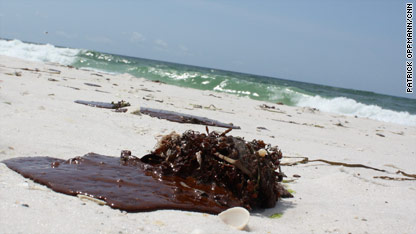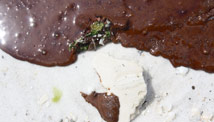
http://www.heraldtribune.com/article/20100605/ARTICLE/6051061/-1/RSS02
ASSOCIATED PRESS / MICHAEL SPOONEYBARGER
A crew picks up oil that washed up along Pensacola Beach, Fla., Friday. Waves of gooey tar blobs were washing ashore in growing numbers on the white sand of the Florida Panhandle Friday as a slick from the BP spill drifted closer to shore.
Published: Saturday, June 5, 2010 at 1:00 a.m.
Last Modified: Friday, June 4, 2010 at 11:46 p.m.
PENSACOLA BEACH — – One of the biggest historic threats to Florida’s economy and environment arrived Friday in the form of black and reddish blobs of oil as large as dinner plates on the sugar-white sands of Santa Rosa Island.
The blobs — some are as small as nickels and dimes, others more than 7 inches in diameter — marked the ominous arrival of the Gulf of Mexico spill that has been creeping toward Florida’s vast coastline since the April 20 explosion of a BP oil rig near Louisiana.
It marked the first time a spill of this magnitude has scarred Florida. Yet the oil that washed up across the Panhandle is expected to be only a sliver of what will be seen across the state in coming weeks.
The impact of the oil spill could potentially be devastating to beachfront communities all along the Florida coast, including the Atlantic if the Gulf currents take the oil spill around the Florida Keys. It could undermine the state’s economy, which remains critically linked to the tourism trade, and could decimate fragile beaches, marshes and coves.
University of Central Florida economist Abraham Pizam said the oil slick could become the worst disaster in the history of Florida tourism.
“It could be the beginning of a major catastrophe for this state,” said Pizam, dean of the Rosen College of Hospitality Management at UCF. “Florida survives on the back of the hospitality industry. For us it’s do or die.”
State Sen. Don Gaetz, R-Niceville, said he is hopeful the tourism industry can recover but believes it will take time.
“Picking up tar balls is going to be a way of life on at least some Florida beaches for months and maybe years,” said Gaetz, in line to become the Senate president in 2012, whose district includes the popular beach town of Destin, where oil is expected soon. “People here have faced extraordinary natural disasters. We’ve rebuilt. We’ve come back and I think we’ll come back from this as well.”
But Gaetz conceded this has the potential to be an unprecedented challenge for Florida
“How could anyone prepare for a catastrophe of this magnitude?” he asked. “This is like a year-long hurricane. The consequences could be much more far reaching than anything I’ve thought about so far.”
In the Pensacola region, the state is countering the spill with an of strategies, among them a flotilla of skimming vessels, booms to block the oil flow into inlets, conservation efforts to save injured animals, and cleanup crews to respond quickly to reports of oil.
Yet the arrival of the tar balls Friday showed those efforts may only deflect and not blunt the oil, which is being pushed toward Florida’s coastline by a strong prevailing wind from the southwest.
State environmental officials said the immediate threat is expected to continue through Tuesday, stretching from Escambia County eastward to other Gulf areas, including Santa Rosa and Okaloosa counties.
Tourists, residents and local officials woke up Friday morning in this beachfront community to find tar balls along the beach. Floating tar mats were found and removed from the Pensacola Pass, which leads into the bays and estuaries surrounding Pensacola.
In less than five minutes, Kaycee Klisart, a bartender at The Dock, a beachside bar, picked up enough tar balls to fill a 16-ounce cup, saying the largest were about the size of her palm although they dissolved when she handled them.
“This is really my livelihood,” Klisart said about the potential impact on the local tourist trade.
Klisart said the beach was “crowded but not like it would be.”
But she also said as a mother of a 10-year-old and a 13-year-old she would not let her children go into the water, although local officials, who are testing the waters, said they remained safe as of Friday.
Lee Mullikin, a retired contractor, and his wife, Pamela Kaster, a retired carpenter’s helper, who have been coming to Pensacola Beach for years, went swimming Friday morning and reported seeing no oil in the water, although they had seen lifeguards picking up small objects earlier in the day.
Mullikin, who went through Hurricane Katrina in New Orleans, said he remembers tar balls on the beach in the late 1970s.
“We’ve come full circle,” he said. “There’s an air of apprehension. It’s like we’re on a death watch here.”
County Commissioner Grover Robinson waded knee deep into the Gulf waters, calling the tar balls an “inconvenience.”
“The beach was open and it looked like a beautiful Escambia County day otherwise,” Robinson said. “We’ve gotten through a number of tragedies and catastrophes. We will do that and we will overcome this issue.”
Robinson said local officials are relying on a strategy to stop the oil at the Pensacola Pass, with plans for as many as 17 booms to block oil if it gets through the pass and starts to threaten the inland marshes and bays.
BP-hired cleanup crews were visible at Pensacola Beach, carrying shovels, plastic bags and gloves as they searched the beach for tar balls.
“We’re doing everything possible,” said Lucia Bustamante, a spokeswoman for BP.
She said 120 workers had been deployed to scour the beaches, beginning Thursday night, with more available if needed and more cleanup crews ready in Panama City if the oil moves further east.
“We have enough resources,” she said.
Mike Sole, secretary of the state Department of Environmental Protection, told local emergency officials that the state had requested more vessels to skim the oil before it reaches the shores and BP has agreed to provide another 20 boats — although Sole said it was not clear when they would arrive.
Dire predictions were the order of the day, as environmentalists woke up in tears and economists worried about the oil spill’s impact on the state’s $66 billion tourism industry.
Environmental activist and Navarre Beach resident Linda Young cried for an hour in the morning, 20 years after founding an anti-oil drilling group in the Panhandle in the hopes of never experiencing a day like Friday.
“It feels like one of your best friends is dying,” said Young, director of the Clean Water Network of Florida, after photographing tar balls on the beach near her home.
Young said the stakes for Florida are enormous as oil keeps gushing from the blown well.
“This is just the beginning. It’s coming wave after wave, and there’s no place on Florida’s coast that’s not at risk,” Young said. “It’s just a nightmare that you can’t wake up from. The full impact of the spill may be felt for years.”

 Nobody knew for sure whether the tar was from the Deepwater Horizon disaster. Local officials said that so much tar had been piling up that they didn’t have the resources to test all the balls and blobs of oil locally, so they would be assuming that if they came in such large amounts now, they were probably from the disaster in the Gulf. Similar tar balls and oil slicks have shown up on beaches along the Gulf since the rig exploded and sank.
Nobody knew for sure whether the tar was from the Deepwater Horizon disaster. Local officials said that so much tar had been piling up that they didn’t have the resources to test all the balls and blobs of oil locally, so they would be assuming that if they came in such large amounts now, they were probably from the disaster in the Gulf. Similar tar balls and oil slicks have shown up on beaches along the Gulf since the rig exploded and sank. 